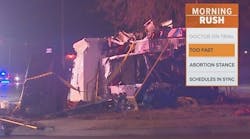The books are almost closed for the year 2006 and the tally of firefighter deaths comes to 106. Barring more deaths that may still occur from events that happened last year this total far exceeds acceptable levels. What are acceptable firefighter death totals? The answer varies from firefighter to firefighter, but, in light of the statistic that tells us that the number of structure fires in our country has decreased significantly over the last several years yet firefighter deaths and injuries have remained the same, then the death toll is wholly unacceptable. With all of the words that are written concerning firefighter safety, all of the training efforts and courses geared toward firefighter safety, all of the national firefighter stand-down days and other safety initiatives, and all of the safety efforts such as engineering controls, administrative controls, and behavior modifications, one would think that the fire service would achieve "critical mass" and the numbers would drop dramatically. But the numbers do not lie! We still have a problem and it is not going away!
Statistically, it is easy to argue that we, as an industry, are not getting better. Less fires - yet the same number of fatalities and injuries. Something is wrong and we need to pull our collective heads out of the sand. Also, just because a fire department has not had a line-of-duty-death (LODD), we do well not to fall into the mental trap that there is not a problem. Prudent fire service leaders are always looking for ways to improve safety and strive to prevent firefighter deaths and injuries.
One of the problems we have is that the eyes that are reading the words right here, right now, are not necessarily the ones that really need the message. Words like these and columns like this are in effect "preaching to the choir". Most of you already know the statistics and concepts that are revealed here. What is needed, then, is people (like you) to share safety messages (like this) with people who do not know. That is your safety challenge today.
Malcolm Gladwell wrote an extraordinarily poignant book called The Tipping Point that has application for the fire service. Gladwell outlines numerous incidents in history where ideas or information spread widely and the surge of acceptance reached critical mass, or the tipping point, quickly. He explains why these things have occurred in detail but a main concept was how the word got out. Gladwell wrote that three things are needed to get a message disseminated and they are; connectors, mavens, and salesmen.
Good ideas need people to spread the message effectively. These people are the "connectors". They know how to reach others and they seem to be well embedded in the community, or industry, and have a vast, intricate network. Think of a spider in the center of its elaborate web where each silk strand is connected to another strand and so forth.
Good ideas also need people who have knowledge of the concepts behind a message and know how to convey the message properly. These people are the "mavens". They are the technical experts who can explain how things work or can reference technical data and share the information in lay terms.
Good ideas prosper with people who can sell the concept. These people are the "salesmen". Good salesmen have techniques to hook people or get them interested in an idea or concept. Good salesmen also know how to keep customers interested. They tend to know how to motivate people to want to "buy-in".
Connectors, mavens, and salesmen may be one in the same or several people.
Gladwell's words application to the fire service are simple; as an industry and occupation we must take the safety message to each and every firefighter and sell them the importance of the safety concepts. To do this we must connect with them through every means possible such as e-mails, written letters, speeches, formal instruction, informal groups, pre and post incident sessions, and so on. We must show them studies, statistics, and case reports to reinforce the desired behavior and even change an ingrained culture. We must apply gentle but relentless pressure to all firefighters concerning the safety message.
So, it is with total respect and great humility that the following statements are offered as extensions to Martin Luther King's "I have a dream" speech from August 28, 1963 in front of the Lincoln Memorial in Washington, D.C. While MLK spoke to thousands that day concerning civil rights, the following statements are directed at the national fire service. The hope is that the people reading this column today will be the connectors, mavens, and salesmen of tomorrow by sharing these words and others like them, with the firefighters, officers, and chiefs of their fire departments. Be a leader, model safety behavior and make a difference!
I have a dream...
- That in 2007 the fire service will experience a 10 percent decrease in firefighter deaths and injuries compared to the previous year and that each year after 2007 the 10 percent decrease continues.
- That fire service leaders show the way toward firefighter safety by modeling appropriate safety behavior, by walking the talk, and not accepting anything less than safe responses.
- That fire service leaders examine core values within their departments and strive to erase the culture of the "swashbuckler" firefighter that has no place in the modern, second millennium fire service.
- That fire service leaders continue to learn more about safety concepts and apply the concepts by writing comprehensive procedures and guidelines, instructing all personnel on those guidelines, and enforcing the guidelines through progressive discipline.
- That fire service leaders become aware of all fire safety initiatives and actively adopt concepts that will bring their department into compliance.
- That fire service leaders realize that when a safety infraction is observed, then ignored, they become liable for all results. "If you condone it-you own it!".
- That fire service leaders hold all personnel accountable and responsible for their behavior.
- That firefighter accountability systems are strictly followed and enforced.
- That supervisors do their jobs without regard to personal relationships.
- That supervisors look at the big picture and prevent personnel from becoming injured.
- That supervisors know the departmental policies, procedures, and operational guidelines and apply them and enforce them at all times.
- That supervisors conduct effective size-ups and risk/benefit analysis and then choose safe tactics in response to observations.
- That supervisors practice collaborative leadership, maintain effective communication, listen to others, and tactfully deal with subordinates.
- That supervisors know the difference between strategy, tactics, and tasks and when to delegate or when to expand the incident command system.
- That supervisors take their role seriously as the "designated adult".
- That supervisors become life-long learners and take their role as an instructor seriously.
- That supervisors know and understand that safety never takes a day off.
- That apparatus drivers know and understand how to safely operate their equipment.
- That equipment maintenance forms are never "pencil whipped" and actual checks are conducted.
- That drivers do not exceed the limitations of their emergency vehicles.
- That drivers keep all wheels of the emergency vehicle on the ground at all times.
- That drivers do not exceed emergency vehicle speed limits and react accordingly to road condition changes.
- That drivers clean their windows and mirrors, adjust their seats, and wear their seatbelts every day they operate the emergency vehicle.
- That drivers utilize back-up personnel every time an emergency vehicle is backed up.
- That drivers know how to position their emergency vehicles at any scene in order to safely operate and protect all personnel.
- That one day emergency vehicles will not be able to move until all personnel are seated and seatbelts are buckled.
- That firefighters follow all directions diligently and avoid "free-lancing".
- That firefighters operate as they have been trained and in accordance with policy, procedures, and guidelines.
- That firefighters utilize all safety equipment as it was designed and in respect to its limitations.
- That firefighters tactfully and immediately notify their supervisors if they notice safety hazards or unsafe conditions.
- That firefighters realize that they will one day be drivers and supervisors and to begin preparing themselves now for those future challenges.
- That all firefighters, regardless of rank, realize and take to heart, (both literally and figuratively), that it behooves them to eat properly and exercise regularly in order to enjoy long lives.
David is a 26 year fire service veteran who serves as an officer on Ladder 6 in Madison, Wisconsin, and as the Operations and Training Director for the department's regional Level A hazmat team. David founded the Wisconsin Association of Hazardous Materials Responders, Inc. and served as the first president. Additionally, David teaches, presents, and authors articles for websites and trade magazines on a wide variety of hazmat topics. David is also a National Fire Academy instructor of chemistry and a Master Instructor for the International Association of Fire Fighters HazMat and Terrorism training programs.





